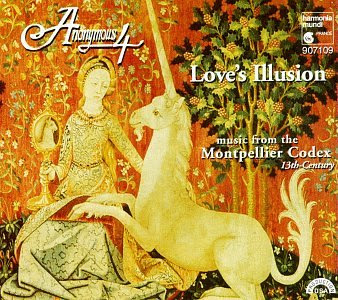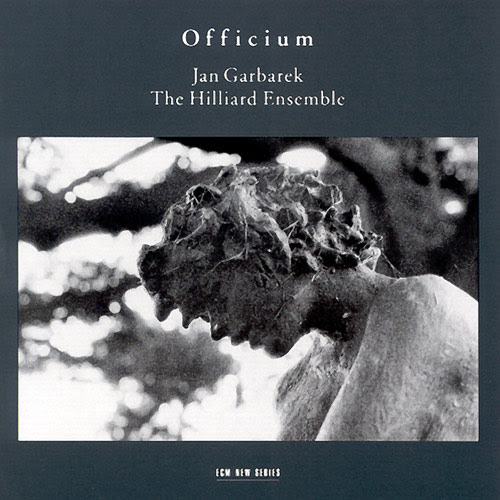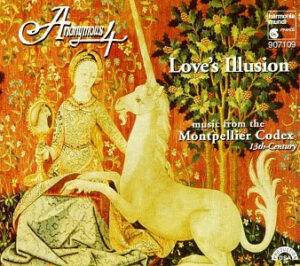Program: #94-35 Air Date: Sep 26, 1994
This program is Free for all, thanks to this generous Preservation Grant:
I. Anonymous 4: Love’s Illusion Music from the Montpellier Codex 13th Century Harmonia Mundi CD HMU 907109

One of the first names we can associate with the Western poetic conceit of "courtly love" as we understand it today is that of the troubadour Duc Guillem IX of Aquitaine (1071-1127). The fin’amors (the phrase originates in the Langue d’oc, an old French dialect from South of France) or true love of Guillem and his contemporaries was usually extramarital and was intended for the young, brave and exceptionally good-looking, who performed renowned deeds in its service. Guillem’s granddaughter Alienor, known to us as Eleanor of Aquitaine, grew up with this literary heritage. As wife to Louis VII of France and Henry II of England, and as mother of Countess Marie de Champagne (d. 1198), with whom she lived for several years, Alienor brought some of the finest poets of fin’amors north with her to various courtly establishments.
The poets of the north, called trouvères, were greatly influenced by the troubadours, but they refined the earthy style of the Provençal lyrics, smoothed its rough edges, and created the genteel rhetoric of fin amours (a phrase that originates in the Langue d’oeïl, an old French dialect from the North of France). From the extensive literature of fin amours there emerge two inviolable precepts: first, true love may exist only outside of marriage and, second, a man must subject himself totally to the will of his beloved, whether her requests seem rational or not. A woman’s physical perfection (often manifested by blond hair and blue eyes) was an outward symbol of her inner goodness, for which a man yearned and suffered, to the point of death. True, this code did raise the woman above the level of pleasure object or chattel in the marriage market, making her both judge and prize in a realm of love outside of marriage. But this elevation only moved her from outright oppression to a starring but essentially passive role in a single dramatic episode.
The romantic love expressed in the literature of fin amours was probably little more than a clever illusion; the reality of day-to-day life remained unchanged. The thirteenth-century ethos of fin amours is found in epic romans of Arthurian legends, by Chrétien de Troyes and others, as well as in thousands of trouvère love lyrics. The lyric poems, generally set to music as melodic chansons without written instrumental accompaniment, form one of the most important musical repertoires of the high Middle Ages. The rhetoric and idiomatic expressions of fin amours and the musical style of the trouvères had a profound influence on the most important polyphonic genre of the thirteenth century: the motet. The motet developed from the common medieval practice of troping—adding words to textless musical passages. In the liturgical polyphony in late twelfth-century Paris, the vocalized lines added to certain plainchants were occasionally texted.
At some point shortly thereafter, such pieces began to be composed independent of direct liturgical associations, and the texted line and the genre itself were called motetus, from the French mot (word). French secular texts were eventually substituted for the sacred Latin words, and a vigorous new musical-literary hybrid was created. There are motets with one, two or three texted voice parts (motetus, triplum, quadruplum), each with its own poetic text above a wordless tenor usually derived from plainchant. There are Latin motets, French motets, and polyglot motets with both Latin and French texts. With two and sometimes three poems sung simultaneously, the motet carries the trope concept to its vertical and horizontal limit, creating an effect not to be heard again until the eighteenth century, in the ensemble finales of Mozart’s operas. For this program we have chosen French motets on courtly love texts from the Montpellier Codex. Collected in France around 1300, this manuscript is the richest single source of thirteenth-century French polyphony. Spanning the entire century, it contains polyphonic works in all the major forms of its era—organum, conductus, hocket and, primarily, motets. Its 315 motets (not counting several duplications and incomplete works) have generally been divided into an early group (about 1200 to 1270, Mo 19 through 252) and a late group (about 1270 to just past 1300, Mo 253 through 345).
The French double motet, by far the most popular type of motet in the thirteenth century, dominates the Montpellier Codex. Its tenor is usually based on a plainchant fragment, but sometimes on a dance or popular tune as in Mo 256, 260, 270, 323, 325 and 337. Each of the two upper voices—motetus and triplum—has its own text. There are also several triple motets (including a third texted part, or quadruplum) among the earlier motet group, as well as many lovely examples of French motets consisting of only a tenor and melody line. Many of the two-voice French motets resemble the chansons d’amour of the trouvères, with an added accompaniment (Mo 200, 223, 231 and 241). In fact, bits of trouvère songs were often incorporated into the upper voices of motets (Mo 21, 111, 128 and numerous others). The texts of the upper voices of a double or triple motet may be so closely related in content that they resemble a verbal theme and variations (Mo 260). However, in some cases, these texts are connected in a surprising manner, with passionate love of the Lady Marian and the Virgin Mary expressed in very similar language (Mo 20 and 21). In yet other cases, the texts seem to bear little connection with each other. In one such motet, a plaintive love song, a diatribe against hypocrisy, and a rousing drinking song are sung simultaneously (Mo 33).
Toward the end of the century, a notational system was developed that allowed for a wider range of note values and more precision in notating them. Motets influenced by this new system show a greater rhythmic flexibility and variety in the upper voices (Mo 256, 270 and 311). In motets attributed to Pierre de la Croix of Amiens (fl. 1270-1300), such as Mo 215 in this program, the three musical lines of the double motet become increasingly differentiated, with a slow-moving tenor, moderate motetus, and a triplum distinguished by rapid declamation. This texture was favored into the fourteenth century, when the motet returned to its sacred origins, expanding in size and scope in the monumental compositions of Guillaume de Machaut and Philippe de Vitry. The motet continued to be an important vehicle for harmonic and structural innovation through the Middle Ages and beyond. There has been much discussion about performance practice of thirteenth-century motets. On what occasions were they performed, by whom, for whom, in what manner?
The predominance of fin amours texts seems to point to the purely secular environment. But the liturgical origins, the use of sacred and moralizing Latin texts (Mo 328), as well as occasional references to the amorous adventures of nuns and monks (Mo 33 and 34), suggests that these motets were composed and performed in clerical rather than in courtly circles, probably for the entertainment of the performers themselves. Many scholars have believed that since motet tenors have essentially lost connection with their chant texts—or never had them in the case of dance tunes—these tenors should be performed on instruments. While this practice may be perfectly valid, there is no evidence that purely vocal performance is not equally appropriate. We have occasionally added vocal drones and doublings, and because these motets, especially those in the early group, are often quite brief, we sometimes perform them more than once in order to highlight one particular voice part or to allow the whole work enough time to make its impression upon hearers whose ears are new to these remarkable old sounds.
SUSAN HELLAUER
- Plus bele que flor / Quant revient / L'autrier joer / FLOS FILIUS Mo21 2'37
- Puisque bele dame m'eime / FLOS FILIUS Mo231 2'02
- Amours mi font souffrir / En mai / FLOS FILIUS Mo111 2'37
- Ne sai, que je die / IOHANNE Mo185 1'23
- Se je chante / Bien doi amer / ET SPERABIT Mo311 2'04
- Or ne sai je que devenir / Puisque d'amer / KYRIELEYSON Mo267 1'48
- Hé Dieus, de si haut si bas / Maubatus / CUMQUE Mo92 1'46
- Celui en qui / La bele estoile / La bele, en qui / IOHANNE Mo20 2'49
- Qui d'amours se plaint / LUX MAGNA Mo215 1'45
- Amours, dont je sui / Lautrier, au douz mois / Chose Tassin Mo270 2'20
- Au cuer ai un mal / ja ne m'en repentirai / Jolietement Mo260 2'55
- Quant voi la fleur / ET TENUERUNT Mo241 2'15
- Quant se depart / Onques ne sai amer / DOCEBIT OMNEM Mo131 1'37
- Joliement / Quant voi la florete / Je sui joliete / APTATUR Mo34 2'59
- Amor potest conqueri / Ad amorem sequitur Mo328 1'19
- Ce que je tieng / Certes mout / Bone compaignie / MANERE Mo33 2'10
- J'ai si bien mon cuer assiz / Aucun m'ont / ANGELUS Mo128 2'12
- Ne m'oubliez mie / DOMINO Mo236 2'35
- J'ai mis toute ma pensee / Je n'en puis / PUERORUM Mo255 2'18
- Blanchete / Quant je pens / VALARE Mo168 2'33
- Dame, que je n'os noumer / Amis donc est / Lonc tans a Mo337 4'32
- Li savours de mon desir / Li grant desir / Non veul mari Mo323 2'05
- Entre Copin / Je me cuidoie / Bele Ysableos Mo256 1'52
- S'on me regarde / Prennés i garde / Hé, mi enfant Mo256 1'52
- Quant yver la bise ameine / IN SECULUM Mo223 1'18
- Ne m'a pas oublié / IN SECULUM Mo134 1’28
- On doit fin[e] Amor / La biauté / IN SECULUM Mo134 1'28
- Ja n'amerai autre que cele / IN SECULUM Mo3 1'28
- Quant je parti de m'amie / TUO Mo200 1'20
II. Officium ECM CD 1525

Jan Garbarek soprano, tenor saxophones
The Hilliard Ensemble
David James countertenor
Rogers Covey-Crump tenor
John Potter tenor
Gordon Jones baritone
Recorded September 1993, Propstei St. Gerold
Engineer: Peter Laenger
Produced by Manfred Eicher
Behold now, I shall sleep in the dust:
and if thou seek me in the morning, I shall not be.
1994 was an intriguing year in music. Jeff Buckley had begun his tragically halted rise to fame with the debut studio album Grace; Portishead brought trip-hop to the mainstream with Dummy; Kurt Cobain shocked many of my generation with his suicide; Pierre Boulez won the Grammy for Best Classical Album with his Deutsche Grammophon recording of Bartók’s The Wooden Prince; and the wildly popular Chant by the Benedictine monks of Silos had taken the North American market by storm. And then there was Officium, a humble recording with the distinction of being the only ECM album I have ever seen advertised on television. I don’t think anyone knew what to expect of its unique combination of soprano and tenor saxophones and choral skimmings from the 12th, 15th, and 16th centuries, but I can still remember the splash it created, selling the better part of a million copies. I made sure to buy mine on the day of its release, simply because of its label and its musicians, and continue to be mesmerized by its sounds to this day. With so many ECM recordings floating through my CD player, it had actually been years since I’d heard this album before revisiting it for this review. I’m pleased to say that, despite the unwarranted flak it has drawn (which, as much as I can tell, is far less than the praise), Officium has aged beautifully and remains a pinnacle of nostalgia in my life as a listener, for it provided some of the most delectable nourishment imaginable at a time when my budding mind was ravenously hungry for new sounds.
At its core is the Hilliard Ensemble’s choice of music, much of it open to interpretation even in its day, by composers such as Pérotin, Pierre de la Rue, and Guillaume Dufay, in addition to a range of earlier anonymous (much of it Czech) material. The opening track, combining Garbarek’s liquid improvisations with the Parce Mihi Domine of Cristóbal de Morales, will always be the one that speaks to me most clearly, if only because it was first to lure my heart into the album’s many inner sanctums. I would say that any claims of disjointedness are quickly dispelled by the anonymous Primo tempore that follows, in which Garbarek’s tenor swells with the mournful quality of an additional human voice. Some tracks are more seamless than others, which is to be expected in the first release of this innovative and ongoing project. Regnantem sempiterna, for example, gives Garbarek less room to work with, forcing him to wriggle his way through a narrower set of possibilities. But then there is the Pulcherrima rosa, during which I sometimes need to remind myself he is even there. There are also those fascinating moments, especially in the Sanctus, when Garbarek descends into unexpected territories, as well as his seductive solo turn in Virgo flagellatur. Either way, Garbarek has an acute ear for vocal contours and matches his playing accordingly. The Hilliards are in typically fine form. Procedentem sponsum and Beata viscera both feature sublime solos from David James, who navigates the droning landscape with utter faith, and Gordon Jones’s* lone rendition of the Gregorian chant Oratio Ieremiae provides some of the loveliest moments on the entire album. Parce mihi domine is reprised at the program’s center (without saxophone) and again at the end (this time, with), thus enacting a tripartite ritual throughout its overall cohesion.
I like to think that Officium led listeners to look at some of ECM’s other fine recordings, if not at other choral albums in general, both new and old. Regardless of any dismissals of this album as a failed New-Age experiment, I like to think of it as a glorious window into a timely solace that enriched the lives of many. Like any album, it may not be for everyone, but one need only take a peek to see what effect(s) it might have.
- Parce mihi domine (Christóbal de Morales, Jan Garbarek, John Potter), 06:42
- Primo tempore (John Potter, Jan Garbarek, Anonymous), 08:03
- Sanctus (John Potter, Jan Garbarek, Anonymous), 04:44
- Regnantem sempiterna (John Potter, Jan Garbarek, Anonymous), 05:36
- O salutaris hostia (Jan Garbarek, Pierre de La Rue, John Potter), 04:34
- Procedentem sponsum (Anonymous, Jan Garbarek, John Potter), 02:50
- Pulcherrima rosa (Jan Garbarek, John Potter, Anonymous), 06:55
- Parce mihi domine (John Potter, Jan Garbarek, Christóbal de Morales), 05:35
- Beata viscera (John Potter, Magister Perotinus, Jan Garbarek), 06:34
- De spineto nata rosa (Jan Garbarek, Anonymous, John Potter), 02:30
- Credo (Anonymous, Jan Garbarek, John Potter), 02:06
- Ave maris stella (Guillaume Dufay, John Potter, Jan Garbarek), 04:14
- Virgo flagellatur (John Potter, Jan Garbarek, Anonymous), 05:19
- Oratio leremiae (Anonymous, Gordon Jones), 05:00
- Parce mihi domine (John Potter, Jan Garbarek, Christóbal de Morales), 06:52
Composer Info
Christóbal de Morales, Jan Garbarek, John Potter, Pierre de La Rue, Magister Perotinus, Guillaume Dufay,,
CD Info
Harmonia Mundi CD HMU 907109, ECM CD 1525
